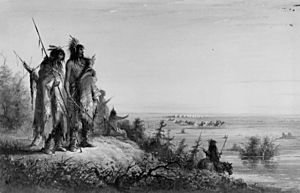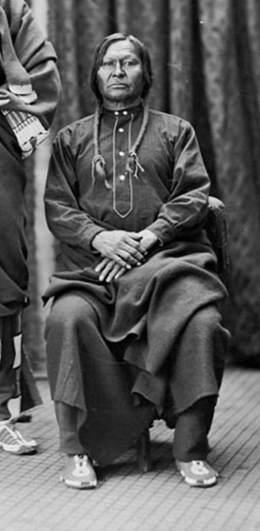Thomas Fitzpatrick (trapper) facts for kids
Quick facts for kids
Thomas Fitzpatrick
|
|
|---|---|
 |
|
| Born | 1799 |
| Died | February 7, 1854 (aged ~55) Washington, D.C., United States
|
| Resting place | Congressional Cemetery, Washington, D.C. |
| Nationality | Irish-American |
| Other names | "Broken Hand" |
| Occupation | Mountain Man, trapper, guide, Indian agent |
| Spouse(s) | Margaret Poisal |
| Children | Friday, Arapaho Chief (unofficially adopted) |
| Parent(s) | John Poisal and Snake Woman |
| Relatives | Chief Niwot (wife's maternal uncle) |
Thomas Fitzpatrick (born 1799, died 1854) was an Irish-American fur trader, a guide, and an agent who worked with Native American tribes. He was known as a "mountain man" because he explored and lived in the Rocky Mountains. He worked for important fur trading companies like the Rocky Mountain Fur Company and the American Fur Company.
Fitzpatrick was one of the first non-Native Americans to find South Pass in Wyoming. This mountain pass later became a key route for pioneers traveling west. In 1831, he found a lost Arapaho boy and helped him get an education. This boy, named Friday, later became an important leader and peacemaker for the Arapaho people.
Thomas Fitzpatrick also guided wagon trains of pioneers heading to Oregon. He helped create important agreements, such as the Fort Laramie Treaty of 1851. He was called "Broken Hand" because his left hand was injured in a gun accident. He died in 1854 in Washington, D.C., after getting pneumonia.
Contents
Early Life and Adventures
Thomas Fitzpatrick was born in County Cavan, Ireland, in 1799. His parents were Mary Kieran and Mr. Fitzpatrick. They were a Catholic family with a good amount of money. Thomas had three brothers and four sisters.
He received a good education. He left home before he was 17 years old. He became a sailor and later left a ship in New Orleans. From there, he traveled up the Mississippi River. He reached St. Louis, Missouri, by the winter of 1822–1823.
Becoming a Trapper

In 1822, Andrew Henry and William Henry Ashley were looking for fur trappers. They put an advertisement in a newspaper called the Missouri Republican. It said they wanted 100 young men to travel up the Missouri River to its source. These men would work for one, two, or three years.
Fitzpatrick decided to join them. He worked with other famous fur traders like Jim Bridger, Jedediah Smith, and William Lewis Sublette. In 1823, he survived an attack during the Arikara War. The Arikara people stopped the trappers from using the Missouri River.
Because of this, Fitzpatrick and Jedediah Smith led 15 men to find a new way over the Rocky Mountains. In 1824, they found South Pass in Wyoming again. This pass had been found before by Robert Stuart in 1811. South Pass became a very important route through the Rocky Mountains to the Pacific Ocean.
From South Pass, they traveled to the Green River basin. This area had many beavers, which were valuable for their fur. Fitzpatrick returned with a large amount of fur pelts. He also led groups of horses carrying goods and supplies over South Pass. These supplies were traded for furs in the Green River area.
The first Rocky Mountain Rendezvous was held on the frontier. This was a big gathering where trappers could trade furs for supplies. It was also a time for fun and entertainment. In 1830, Fitzpatrick became a main partner in the Rocky Mountain Fur Company.
In 1832, Fitzpatrick had a scary experience. He was riding ahead of a supply group and was chased by members of the Gros Ventre tribe. This event is said to have made his hair turn gray very early. He later led a group of Native Americans and trappers against the Gros Ventre in the Battle of Pierre's Hole. The Rocky Mountain Fur Company ended in 1834. Fitzpatrick continued to work in the fur trade for other companies.
Helping an Arapaho Boy

In 1831, Thomas Fitzpatrick found a young Arapaho boy. The boy had been separated from his family. His family had been camping with the Atsina (Gros Ventre) people near the Cimarron River in what is now Colorado. A fight had broken out between the groups.
Fitzpatrick found the boy on a Friday, so he named him Friday. Fitzpatrick took Friday in and sent him to school in St. Louis, Missouri, for two years. After school, Friday traveled with Fitzpatrick on his trapping trips in the western frontier.
In 1838, Fitzpatrick and Friday met a group of Arapaho people. A woman recognized Friday as her son. Friday then returned to live with his Arapaho family. He and Fitzpatrick remained friends until Fitzpatrick's death in 1854.
A Skilled Guide
When the fur trade became less profitable, Fitzpatrick became a guide. He led some of the first groups of settlers traveling by wagon to Oregon. This included the Whitman-Spalding Party in 1836 and the Bartleson-Bidwell Party in 1841.
He was also the official guide for John C. Frémont on his important expedition from 1843 to 1845. In 1845, he guided Colonel Stephen W. Kearny and his soldiers, called Dragoons. They traveled along the western trails to show their strength to Native American tribes.
Working as an Indian Agent
In 1846, Fitzpatrick became an Indian Agent for a large area. This area included the Upper Platte and Arkansas River Valleys, which is a big part of present-day Colorado. He was well-respected by both Native Americans and white settlers.
He worked with the Arapaho, Cheyenne, and Lakota Sioux tribes of the Central Plains. Fitzpatrick was a key negotiator for the Fort Laramie Treaty of 1851. This was the largest meeting ever held with Native American tribes of the Plains. He also helped negotiate the Treaty of Fort Atkinson in July 1853. This treaty was with the Plains Apache, Kiowa, and Comanche tribes.
Family Life
In November 1849, Thomas Fitzpatrick married Margaret Poisal. Margaret was the daughter of a French-Canadian trapper named John Poisal and an Arapaho woman named Snake Woman. Margaret was also the niece of Arapaho Chief Land Hand, also known as Chief Niwot.
Thomas and Margaret had a son, Andrew Jackson Fitzpatrick, born in 1850. Their daughter, Virginia Tomasine Fitzpatrick, was born in 1854, after her father had passed away.
Margaret Poisal was an important translator for the Arapaho people. She often worked with Fitzpatrick at important meetings. After his death, Margaret continued to serve as the official interpreter for the Arapaho. She helped during the Little Arkansas Treaty Council in 1865.
Death and Lasting Impact
In the winter of 1853–54, Fitzpatrick traveled to Washington, D.C.. He went there to finalize the Treaty of Fort Atkinson. While in Washington, he became sick with pneumonia and died on February 7, 1854. He was buried in the Congressional Cemetery in Washington, D.C.
In 2004, Thomas Fitzpatrick was honored. He was inducted into the Hall of Great Westerners at the National Cowboy & Western Heritage Museum.
Popular Culture
Thomas Fitzpatrick has been shown in television shows. In a 1966 episode of the TV series Death Valley Days, actor Morgan Woodward played Fitzpatrick. The episode was called "Hugh Glass Meets the Bear."
See also
 In Spanish: Thomas Fitzpatrick para niños
In Spanish: Thomas Fitzpatrick para niños

